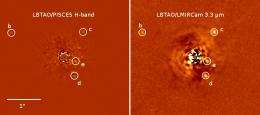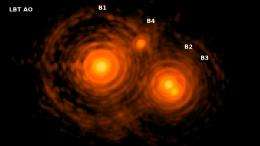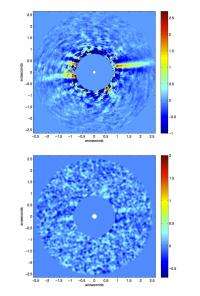Large Binocular Telescope brings the Universe into sharper focus

(PhysOrg.com) -- Today astronomers from the Large Binocular Telescope (LBT) released the first series of scientific results showing its best-in-the-world performance in canceling the blur of the Earth’s atmosphere. Included in these first findings are previously impossible discoveries about extrasolar planets and their environments and new insights into how stars are formed.
The LBT is the first in the new generation of extraordinary large ground-based telescopes that uses advanced adaptive secondary mirrors to see more clearly than ever before. The LBT utilizes two giant 8.4 meter mirrors (27.5 feet) and is located on Mt. Graham in southeastern Arizona.

“With this unrivaled new technology, we can now probe the close-in environments of nearby stars with a clarity that was previously not possible,” said Richard Green, Director of the LBT. “We expect these to be the first of many amazing new discoveries as we are now able to observe in unique detail the formation of stars and their systems of planets.”

-- Exoplanets observed close to their host star: LBT has measured in unprecedented detail the fourth, innermost planet in the HR8799 planetary system, located more than 128 light-years from Earth. These LBT observations significantly revise previous understanding of the atmospheres of the four planets.
-- A better look at star formation: LBT observations of the Trapezium region in Orion were able to determine the positions of young stars in their orbits around each other with seven times greater accuracy than any previous study. These results confirm a long-suspected theory about the nature of star formation.
-- A new view of an intriguing debris disk: The LBT was able for the first time to probe more deeply into the interior of the debris disk surrounding the star HD 15115, revealing a symmetrical structure quite different from previous observations by other telescopes, including the Hubble Space Telescope.
Provided by Large Binocular Telescope










.jpeg)








